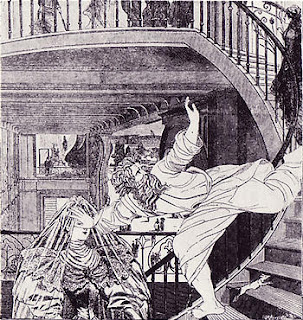Here they are:
Both include more or less direct references to Ernst, the first in form of a Victorian wood engraving, the second in form of a quasi 'headless' woman as a reference to his 'Hundred Headless Woman'. The first collage is also of course a take on mythology, connecting Egyptian beliefs with images of the moon (The type in the centre is German and says 'The Moon – Sensualised portrayals of this celestial body that is the closest to us').
The second collage was inspired by travels through the Balkans and its richness in landscape and culture, but also its troubled past. When I was there I was particularly fascinated by the way East and West coexist and mingle over there – mosques next to churches next to synagogues, moorish carvings in the midst of soviet concrete blocks. That is why I included Arabic newspaper type and old Italian stamps.
The second series I created was inspired by one of my favourite poems, 'The Love Song of J. Alfred Prufrock' by T.S. Eliot. I decided to make illustrations for the last three lines, because I find them so evocative: 'We have lingered in the chambers of the sea / By sea-girls wreathed with seaweed red and brown / Till human voices wake us and we drown'.
This time, I have decided to colour code the images and include fewer of my drawings. As you can see, this did not result in a lack of texture! I am especially happy with how the last one turned out, because it is a more abstract spin on Eliot's poem, while the first to a fairly straight-forward illustrations. To me, 'Prufrock' is a take on modern life and isolation and I found that a cityscape was a good way of portraying this.







